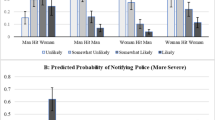Abstract
The current study proposed and tested a series of competing hypotheses about intimate partner violence in the 2006 National Incident Based Reporting System (NIBRS), a dataset of criminal incidents known to the police. Three research questions were presented concerning gender differences in victim identity, victim-offender relationships, and victim injury with hypotheses derived from the feminist, family violence, and general violence perspectives. Victim-based analyses were consistent primarily with expectations of the feminist perspective, although aspects of the general violence perspective were supported as well: Women were more likely than men to experience violence from an intimate; they were more likely to experience violence from an intimate partner than from any other perpetrator; and when victimized by an intimate, women were usually more likely to be injured. These results highlight the uniqueness of violence between intimates relative to other types of violence.
Similar content being viewed by others
References
Addington, L. A., & Rennison, C. M. (2008). Rape co-occurrence: do additional crimes affect victim reporting and police clearance of rape? Journal of Quantitative Criminology, 24, 205–226.
Archer, J. (2000). Sex differences in aggression between heterosexual partners: a meta-analytic review. Psychological Bulletin, 126, 651–680.
Brush, L. D. (1990). Violent acts and injurious outcomes in married couples: methodological issues in the National Survey of Families and Households. Gender and Society, 4, 56–67.
Bureau of Justice Statistics (2005). Family violence statistics. U.S. Department of Justice, Office of Justice Programs, Washington, DC
Buzawa, E. S., & Hotaling, G. T. (2006). The impact of relationshp status, gender, and minor status in the police response to domestic assaults. Victims & Offenders, 1, 323–360.
Dobash, R. P., Emerson Dobash, R., Wilson, M., & Daly, M. (1992). The myth of sexual symmetry in marital violence. Social Problems, 39, 71–91.
Dobash, R. P., & Dobash, R. E. (1995). Reflections on findings from the violence against women survey. Canadian Journal of Criminology:457–484.
Federal Bureau of Investigation. (2004). “Uniform Crime Reporting Handbook.” U.S. Department of Justice, Washington, D.C.
Felson, R. B. (1996). Big people hit little people: sex differences in physical power and interpersonal violence. Criminology, 34, 433–454.
Felson, R. B. (2002). Violence and gender reexamined. Washington: American Psychological Association.
Felson, R. B., Ackerman, J., & Yeon, S.-J. (2003). The infrequency of family violence. Journal of Marriage and the Family, 65, 622–634.
Felson, R. B., & Cares, A. C. (2005). Gender and the seriousness of assaults on intimate partners and other victims. Journal of Marriage and the Family, 67, 1182–1195.
George, M. J. (1994). Riding the donkey backwards: men as the unacceptable victims of marital violence. Journal of Men’s Studies, 3, 137–159.
Henning, K., Renauer, B., & Holdford, R. (2006). Victim or offender? Heterogeneity among women arrested for intimate partner violence. Journal of Family Violence, 21, 351–368.
Johnson, M. P. (1995). Patriarchal terrorism and common couple violence: two forms of violence against women. Journal of Marriage and the Family, 57, 283–294.
Johnson, M. P. (2005). Domestic violence: it’s not about gender—or is it? Journal of Marriage and the Family, 67, 1126–1130.
Johnson, M. P., & Ferraro, K. J. (2000). Research on domestic violence in the 1990s: making distinctions. Journal of Marriage and the Family, 62, 948–963.
Kernsmith, P. (2005). Exerting power or striking back: a gendered comparison of motivations for domestic violence perpetration. Violence and Victims, 20, 173–185.
Kurz, D. (1989). Social science perspectives on wife abuse: current debates and future directions. Gender and Society, 3, 489–505.
Lenton, R. L. (1995). Power versus feminist theories of wife abuse. Canadian Journal of Criminology, 37, 305–330.
Miles-Doan, R. (1998). Violence between spouses and intimates: does neighborhood context matter. Social Forces, 77, 623–645.
O’Neill, D. (1998). A post-structuralist review of the theoretical literature surrounding wife abuse. Violence Against Women, 4, 457–490.
Perry, A. R., & Fromuth, M. E. (2005). Courtship violence using couple data: characteristics and perceptions. Journal of Interpersonal Violence, 20, 1078–1095.
Phelan, M. B., Hamberger, L. K., Guse, C., Edwards, S., Walczak, S., & Zosel, A. (2005). Domestic violence among male and female patients seeking emergency medical services. Violence and Victims, 20, 187–206.
Rothenberg, B. (2003). “We don’t have time for social change”: cultural compromise and the battered woman syndrome. Gender and Society, 17, 771–787.
Stanley, J. L., Bartholomew, K., Taylor, T., Oram, D., & Landolt, M. (2006). Intimate violence in male same-sex relationships. Journal of Family Violence, 21, 31–41.
Steinmetz, S. (1978). The battered husband syndrome. Victimology: An International Journal, 2, 499–509.
Stolzenberg, L., & D’Alessio, S. J. (2008). Co-offending and the age-crime curve. Journal of Research in Crime and Delinquency, 45, 65–86.
Straus, M. A. (1980). The marriage license as a hitting license: evidence from popular culture, law, and social science. In M. A. Straus & G. T. Hotaling (Eds.), The social causes of husband-wife violence (pp. 39–50). Minneapolis: University of Minnesota Press.
Straus, M. A. (2007). Processes explaining the concealment and distortion of evidence on gender symmetry in partner violence. European Journal of Criminal Policy Research, 13, 227–232.
Straus, M. A., & Gelles, R. J. (1986). Societal change and change in family violence from 1975 to 1985 as revealed by two national surveys. Journal of Marriage and the Family, 48, 465–479.
Straus, M. A., Gelles, R. J., & Steinmetz, S. (1980). Behind closed doors: violence in the American family. Garden City: Doubleday.
Tjaden, P., & Thoennes, N. (2000). Prevalence and consequences of male-to-female and female-to-male intimate partner violence as measured by the National Violence Against Women Survey. Violence Against Women, 6, 142–161.
Acknowledgement
Special thanks are extended to Alfred DeMaris and David F. Warner, as well as the anonymous reviewers, for comments on earlier drafts of this article.
Author information
Authors and Affiliations
Corresponding author
Rights and permissions
About this article
Cite this article
Warner, T.D. Violent Acts and Injurious Consequences: An Examination of Competing Hypotheses About Intimate Partner Violence Using Agency-Based Data. J Fam Viol 25, 183–193 (2010). https://doi.org/10.1007/s10896-009-9282-z
Published:
Issue Date:
DOI: https://doi.org/10.1007/s10896-009-9282-z




